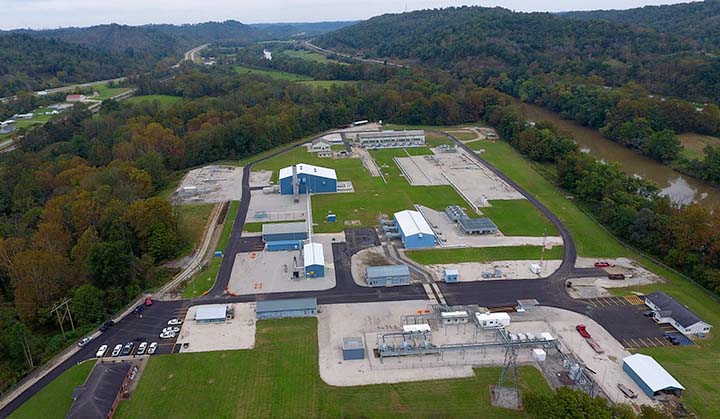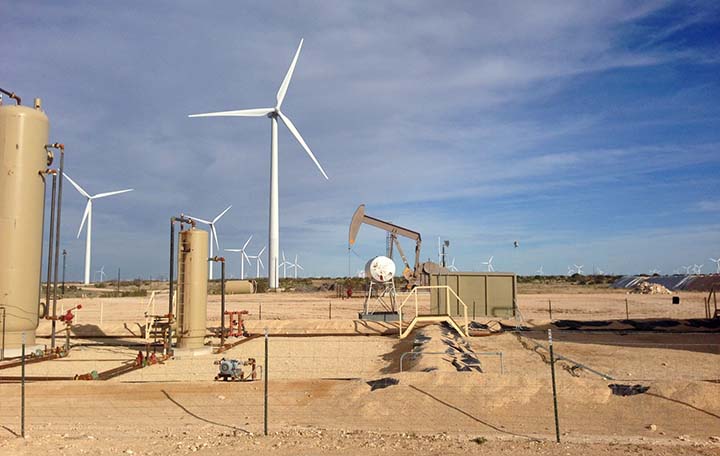Clean Energy Opportunities in the Oil and Gas Sector
Jan. 18, 2022—As the U.S. energy system is transitioning to lower-carbon energy sources, the oil and gas industry is becoming more interested in decarbonization, increased resilience, and conserving high-value resources. This transition comes with important economic and environmental decisions.
“Oil and gas resources remain critical to our energy and economic future over the next decade,” said Emily Newes, energy analyst at the Joint Institute for Strategic Energy Analysis (JISEA). “Integrating clean energy technologies in oil and gas operations could help meet sustainability targets while satisfying continued demand for high-value oil and gas resources.”
Newes and fellow JISEA researchers completed case studies on the potential benefits of incorporating clean energy technologies with and without net metering in two parts of the oil and gas value chain. This work was sponsored by a JISEA consortium including ConocoPhillips, Baker Hughes, Extraction Oil & Gas, Kinder Morgan, and the Interstate Natural Gas Association of America Foundation to understand site-specific energy consumption, prices, and opportunities for clean energy integration.
Profitable Options for Compressor Stations: Smaller-Size Renewable Energy Technologies

Example compressor station, which plays an important role in transporting natural gas to end users. Photo from Kinder Morgan
In the first case study, JISEA modeled an all-electric compressor station in west Texas owned by Kinder Morgan. Compressors sustain the pressure and flow of natural gas to transport it from the well to customers. The Texas site includes 30 acres of available land for potential clean energy development.
JISEA used NREL’s REopt tool, an energy planning platform that recommends the optimal mix of renewable energy, conventional generation, and energy storage technologies for an energy system to meet cost savings, resilience, and energy performance goals.
The team modeled the techno-economic potential of solar photovoltaic (PV), wind, and battery energy storage based on the load they can offset, the site’s available land, and hypothetical carbon pricing. The results were presented virtually at the Interstate Natural Gas Association of America’s annual meeting.
REopt results show smaller-size renewable energy systems can be cost-effective for compressor stations. “It’s currently hard for renewable energy technologies to compete with the low cost of electricity at these large sites,” said lead author and JISEA analyst Emma Elgqvist. “But they can provide benefits beyond cost savings, like resilience and emissions reduction.”
The economics of large-scale renewable energy systems can be more challenging but provide substantial emissions reductions and contribute to sustainability goals. As modeled, larger systems that generate half of the site’s load could offset significant amounts of CO₂ but at an added cost that results in a negative net present value. For a renewable energy system that generates half of the site’s load, a carbon cost of $40 per ton of CO₂ emissions represents the break-even carbon price. As large-scale renewable energy technology costs continue to decrease across the country, larger systems could make economic sense for compressor stations.
Profitable Options for Oil Fields: Smaller-Size Renewable Energy Technologies, Microgrids

An oil field site in the Delaware Basin in west Texas. Photo from iStock
In the second case study, JISEA analyzed clean energy options for a ConocoPhillips oil field in the Delaware Basin—part of the larger Permian Basin that produces about 40% of all U.S. oil. The Delaware Basin stretches from west Texas to southeastern New Mexico and has significant available land for potential clean energy development.
JISEA used the REopt tool to model different clean energy technology configurations based on the load they could offset, the site’s available land, and hypothetical carbon pricing.
Much like with compressor stations, oil field operations would benefit the most from smaller renewable energy technologies that generate 5% of the site’s load.
As modeled, larger PV systems that generate half of the site’s load could offset large amounts of CO₂ at an added cost that results in a negative net present value. For a PV system that generates half of the site’s load, a carbon cost of $7 per ton of CO₂ emissions would offset the additional costs of PV over conventional energy generation.
In addition to smaller renewable energy technologies, microgrids with battery energy storage could benefit the oil field site by increasing resilience from electric utility outages and creating opportunities for higher value streams from distributed energy resources.
“Microgrids can be a highly effective toolkit for oil and gas operations that can assist in overcoming not just operational challenges but in meeting sustainability benchmarks established and increasingly demanded by the public,” said Ricardo Castillo, JISEA analyst and co-author of the technical report.
Future research could expand the REopt analysis to cover more compressor stations and oil wells where larger PV-plus-storage systems could be developed and provide power back to the grid.
Read the full case study on clean energy integration in compressor station operations and INGAA presentation on the results. Read the full case study on clean energy integration in oil field operations.
Back to JISEA News >
